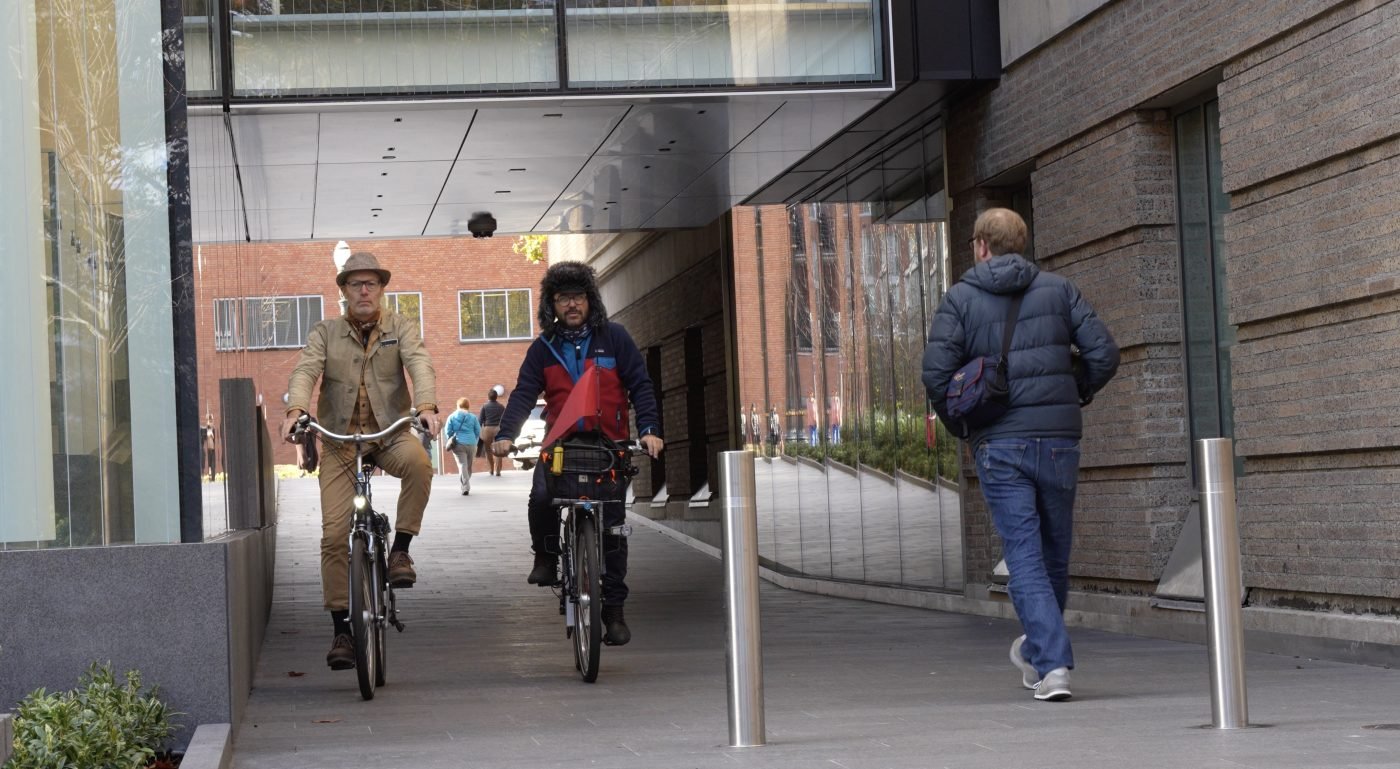When I experienced the bike path through the Rijksmuseum in Amsterdam for the first time in 2013, I was awe-struck. I called it (along with the Hovenring bike bridge in nearby Eindhoven) one of the two “wonders of the bicycle world” and it remains one of the coolest pieces of bike infrastructure I’ve ever seen.
I would have never expected to have something similar here in my own city; but with the opening of the Portland Art Museum’s (PAM) new Rothko Pavilion Thursday, the unexpected has become reality. Portland has added an amazing piece of civic architecture-slash-transportation infrastructure to the Central City that belongs right up there with Pioneer Square, the Aerial Tram, and the Tilikum Bridge. Officially named the Pat and Trudy Ritz Passageway, the tunnel pierces a new glass pavilion that connects two museum buildings and allows walkers and rollers to move freely between SW Park and SW 10th avenues. The design also allows passersby to peer into museum galleries, while visitors inside can watch tunnel traffic as they walk across the skybridge between the two buildings.
The tunnel is a triumph and stands as a powerful demonstration of Portland’s commitment to walking and biking. But what’s most remarkable (and mostly forgotten) is that it almost never happened and was not part of the initial plans.
When PAM first shared designs of the Rothko Pavilion expansion in 2016, there was no tunnel through it. As word spread, local residents and biking and walking advocates voiced concerns about how the pavilion would cut off access across the former plaza. In early 2017, I began to report on those concerns and opposition to PAM’s plans grew. Museum leaders incorrectly assumed that Portlanders would happily trade public plaza access for a major upgrade to this important institution. They were wrong. Local residents, advocates, and even City of Portland planning commissioners, attached great value to the permeability of that plaza and PAM’s attempt to change the public easement through the property that had existed since 1968 was met with stiff resistance. Once plans to close access to the plaza became widely known, the city’s bicycle and pedestrian advisory committees came out in opposition against it and pushback at its first city council hearing was so stiff, a decision on the design was delayed.
In response, PAM came up with a new plan in November of 2017 they hoped would quell resistance. PAM Director Brian Ferriso even attended a PBOT Bicycle Advisory Committee meeting to ask for support from cycling advocates. Unfortunately for PAM, the proposal didn’t go far enough because it still closed off the plaza and would only allow people to walk bikes through an enclosed pavilion structure.
Ferriso tried to convince BAC members that the tradeoff would be worth it: Yes, folks would have to walk through the museum to get across the block, he explained; but in exchange they’d get a major investment into the museum. But biking and walking advocates weren’t having it. Former BAC member Chris Achterman told Ferriso, “If this is a door, that’s not going to work. I hope that as you approach this project you see it as Portland’s version of the Rijksmuseum.”
Nearly one year after that BAC meeting, PAM and Ferriso finally relented, the tunnel proposal emerged, the advocates were satisfied, and Portland got its version of the Rijksmuseum tunnel.
I got chills Thursday as the gentle downhill grade pushed me and my bike into the glass gallery. Nodding and smiling at others who seemed similarly smitten with this novel passageway, I recalled the effort it took and the people who spoke up to make it a reality.
As I stopped to prep for another ride through, Portland Mayor Keith Wilson walked by. He wasn’t aware of the tunnel’s history, but he knew it was cool. “I’m so glad we have it,” he said as he walked through it with the excited urgency you’d expect from a mayor who’d just cut the ribbon on something that will help his efforts to revitalize downtown. “It’s extraordinary. This is what you talk about as far as urban living — where you bring the active transportation into the actual cityscape. It’s what makes a community a community. You look to to your right and you’re actually in a museum while you’re going down a city street. It’s brilliant.”
By “city street” Wilson was referring to SW Madison, which was closed off at SW Park in 1968 to build the museum. That closure came with a condition that the museum would maintain a public easement through the plaza. It was that easement PAM officials initially wanted to change, and that the new tunnel keeps constant.
In addition to the new passageway, there’s a new bike parking area on the SW Park side that has four stainless steel staple racks. When I noticed a very proud and well-dressed woman taking photos in front of a plaque nearby that read, “Barbara Bours Brady Bike Bay,” I figured she was likely the donor. Sure enough, it was Brady. Turns out Brady is an avid cyclist who’s logged over 130,000 miles as a member of the Portland Bicycling Club since the 1980s.
“I’ve cycled for many, many years and I wanted people to have a place to park their bikes so they didn’t have to drive their cars in downtown Portland, including myself!” Brady, a long time museum donor and resident of downtown, told me Thurdsay. “I have to get some dressy black pants so I can bike up here and if I get a little grease on them it won’t matter!” she added.
Judging by the crowded racks on Thursday, she won’t be the only one. The new pavilion — and the tunnel that runs through it — appear to be an instant hit.
— Go check out this fantastic addition to the museum and bike and/or walk through a tunnel a few times. Access to the museum is free through Sunday, November 23rd. See PAM’s website for more info.




